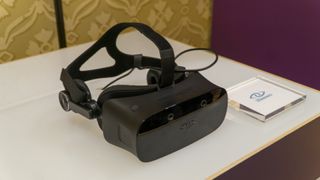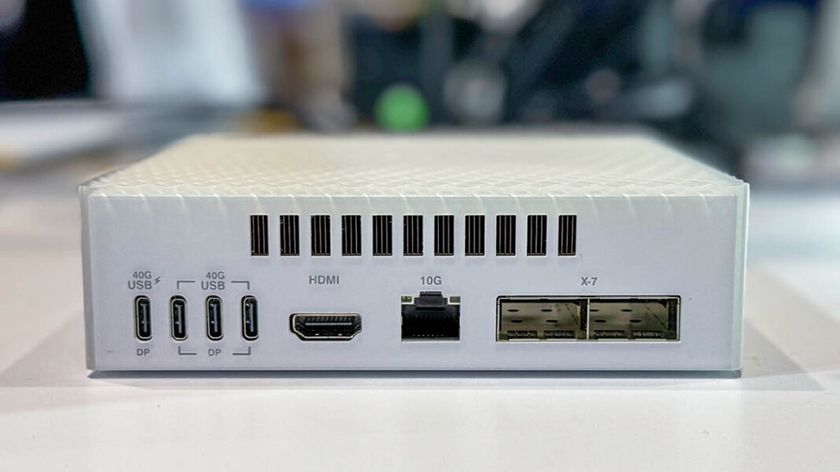Here’s what the first wave of Windows 10 VR headsets look like
Five different takes on Microsoft’s reference design

Let the big VR democratization begin
Since their tease during Microsoft’s big Surface Studio and Windows 10 Creators Update event in New York back in October, we’ve been waiting to see exactly what these Windows 10 VR headsets running Windows Holographic will look like when they begin launching later this year alongside that very operating system refresh.
At CES 2017, the first wave of these head-mounted displays (HMDs) has arrived – though with all but one under glass. Microsoft held a special event during the show to give the press a sneak peek at how these headsets will look, and the firm also laid out some of its expectations for its partners’ devices.
- These are the best laptops for college students in 2017
Five of these headsets were on display, from Acer, Dell, HP, Lenovo and a company known as 3 Glasses. So, let’s get right to it, shall we? (You’ll notice that all five of these devices look awfully similar – the reasons for which will quickly become apparent.)
Oh, and one more thing: only two of Microsoft’s initial partners – Lenovo and 3 Glasses – were prepared to give any more information regarding their headsets than what we could glean from outside the glass cases.
New year, new tech – check out all our coverage of CES 2017 straight from Las Vegas, the greatest gadget show on Earth.

Acer’s HMD
Microsoft Marketing Director Warren Langevin tells us that the company expects each headset launched under the Windows Holographic platform to house screens that come in at a resolution of 706 pixels-per-inch (ppi) between both panels.
(For those keeping score, the Oculus Rift’s lenses come in at 461 ppi, while the HTC Vive’s screens amount to 447 ppi.)
Now, above you see Acer’s device, which houses two front-facing cameras for head-tracking first and possibly controller-tracking down the line. We’re really digging the Virtual Boy vibe here, though hopefully that’s not indicative of its quality.

Dell’s HMD
Langevin also says that the headsets will be expected to run on a USB interface, as per the Windows Holographic spec. The two front-facing cameras you saw on Acer’s device, Dell’s and will see on all the others is another expectation from the HoloLens maker for its partners.
We’ve been told that the front-facing cameras aren’t mandatory, but they may as well be. Without those cameras, these headsets would require tracking setups like that of HTC and Oculus’s, which would defeat Microsoft’s goal of making VR as dead simple as possible.
Dell’s headset looks much more sterile than the others, like something out of 2001: A Space Odyssey. And, don’t worry: they're hard to make out, but those two cameras are in there, too.

HP’s HMD
Finally, Langevin tells us that all of these headsets will use Microsoft's own Windows Holographic interface, to maintain a level of parity between all of the HMDs.
HP’s take on the Windows 10 VR headset looks much more Tron-like than the others, and a logo reveals a bit more about the firm’s ambitions with it: 1,440 x 1,440 resolution per display.

Lenovo’s HMD
At this point, it’s clear how similar all five of the HMDs revealed at the show appear to be. But, that’s not just because of Microsoft’s expectations.
Each firm has clearly taken liberal design inspiration from both Microsoft’s own HoloLens design as well as Sony’s PlayStation VR. They are the most comfortable out there that we’ve tested, after all.
Lenovo actually revealed its prototype HMD before CES 2017 even began, outright saying that its lenses, too, will sport 1,440 x 1,440 resolution. Furthermore, the firm expects the device to weigh much lighter than the two leading PC VR headsets at around 350g. Lenovo expects the device to cost between $300 and $400 dollars.

3 Glasses Blubur S1
This firm seems to be the most ready to discuss the capabilities of its Windows 10 VR HMD, the Blubur S1. Designed more like the Oculus Rift, its screens come out to 704 ppi for a 2K total resolution.
Also, the Blubur S1’s refresh rate is clocked at 120Hz, to better guarantee you won’t hurl while using it. And finally, the device offers a 100-degree field of view and built-in headphones – something none of the others currently offer. You check out the Blubur S1 in full right here.
Boy, can we not wait for the Creators Update to launch this spring.

Joe Osborne is the Senior Technology Editor at Insider Inc. His role is to leads the technology coverage team for the Business Insider Shopping team, facilitating expert reviews, comprehensive buying guides, snap deals news and more. Previously, Joe was TechRadar's US computing editor, leading reviews of everything from gaming PCs to internal components and accessories. In his spare time, Joe is a renowned Dungeons and Dragons dungeon master – and arguably the nicest man in tech.



















